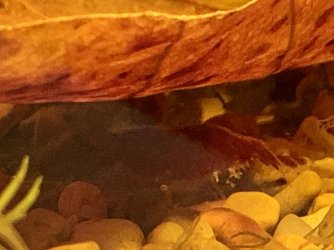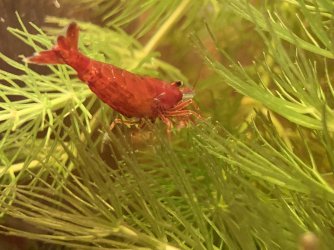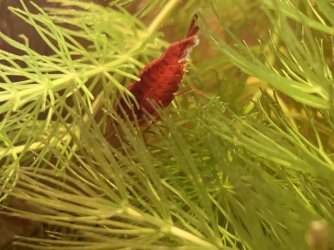This shrimp tank was started 7 months ago and is a 5.5 gallon tank. I use RO water and remineralize with GlasGarten Shrimp Mineral. There is a sponge over the intake and I squeeze it out weekly to improve flow. The filter is for a 10 gallon tank and the flow is adjustable, so the filtration is sufficient. It was started with 8 shrimp and babies first came at the end of May. Babies have been coming regularly ever since. These shrimp are fed Hikari Crab and Shrimp Cuisines, Logemann Bros. products, organic veggie pieces. I try to provide a varied diet. There are water fleas and amphipods in the tank. Planaria have been in the tank since the start, probably came in on plants and I kept removing them manually. Last week I picked up some Prazipro and dosed my little shrimp tank hoping it might assist in getting rid of the planaria.
Water parameters on 10/24
0 Ammonia
10 Nitrate
0 Nitrite
150 GH
40 KH
6.4 pH
0 Chlorine
Temp 70.8F
I noticed one of my beautiful shrimp had some white areas underneath so I did some online researching to identify what might be going on. I did just see this shrimp molt and thought perhaps those white areas were injuries from scratching across some hornwort as the tank has heavy vegetation and the majority of the tank area is quite “bushy” looking. It seems to be Scutariella Japonica. Would you agree with that assessment?
The treatment for this nematode seems to vary and the websites have their own opinion on how much aquarium salt and water to use. I’ve seen 1 teaspoon to a cup of aquarium water, 1 Tablespoon salt to a glass of water, and if the whole tank is infested use 1 Tablespoon per 5 gallons of tank water, etc…. So I am unsure of the dosing. My first thought is “what the hell??!!” when it is said to dose 1 cup of water as heavily as 5 full gallons of water with the same amount of aquarium salt.
The aquarium salt container recommends treating with 1/16th of a Tablespoon per 1 cup of water for disease treatment and it is what I’ve used this morning for that shrimp’s first salt bath. I had her in there for 1 minute. I have not seen this on any other shrimp in the tank, but like I said, she did just molt the other day when I did a small water change (less than 1.5 quarts). Many shrimp did eat the molt though so now I’m wondering if I’m going to see more of this on the other shrimp in the tank. I will be on the lookout for molts now until mid-November and will be removing them from the tank. It won’t be easy to find them all since this tank is very much an underwater jungle.
So I am not looking for what you can research and find online and parrot back at me, but I will review other websites and videos if you want to share a link. I’m looking for real life experience with Scutariella Japonica and how did you overcome the problem. What salt bath recipe or other remedy worked for you. Please share your experience with Scutariella Japonica.
Thanks so much.
Now I’m going back with my cup of coffee to look into my water cubes. <smile>





